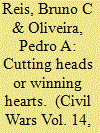|
|
|
Sort Order |
|
|
|
Items / Page
|
|
|
|
|
|
|
| Srl | Item |
| 1 |
ID:
111222


|
|
|
|
|
| Publication |
2012.
|
| Summary/Abstract |
In the early 1970s, Portugal still held on to the oldest European colonial empire, resisting the winds of decolonization in Africa. In this period, the Portuguese were fighting counterinsurgency campaigns in three of its overseas territories: Angola, since 1961; Guinea, since 1963; and Mozambique, since 1964. This article focuses on the counterinsurgency campaign in Mozambique because it was there, in 1972, that the most serious known atrocity took place, at least in terms of its international impact, from these unconventional wars. The appointment of a new commander-in-chief, Kaúlza de Arriaga (1970-73), to Mozambique intensified the war. Larger airborne search and destroy operations were carried out in an attempt to win the campaign quickly and decisively. It was in this context that the killing of civilians took place somewhere around the town of Tete in December 1972, which was eventually followed by an international outcry in response to its public denunciation by Catholic missionaries. The exact location, even the existence of Wiriyamu, as well as the extent of the atrocities, remain contentious. This article will use multiple sources to clarify as far as possible: what happened, why it happened, and its implications for the dynamics of counterinsurgency and intra-state wars generically. Furthermore, it will address specifically what it meant for the Portuguese way in counterinsurgency, until the rapid end of multiple campaigns as a result of a military coup in April 1974, in which Mozambique and the stain of Wiriyamu loomed large.
|
|
|
|
|
|
|
|
|
|
|
|
|
|
|
|
| 2 |
ID:
104333


|
|
|
|
|
| Publication |
2011.
|
| Summary/Abstract |
This article argues that the dominant paradigm in studies of British small wars positing a central role of minimum force in doctrinal guidelines for counterinsurgency needs to be even more fundamentally revised than has been argued in recent debates. More specifically, it argues that minimum force is nowhere to be found in British doctrine during the small wars of decolonisation. The need for revision also applies to the way British counterinsurgency is usually sharply contrasted with French counterinsurgency. British doctrine during this period is better understood when placed in its proper historical context. This means comparing it with the other two most significant examples of doctrinal development for small wars of decolonisation - those of France and Portugal. This comparison shows that British counterinsurgency was not uniquely population-centric, and this characteristic cannot, therefore, be the reason for its arguably superior if far from infallible performance. Evidence for these arguments comes primarily from doctrinal sources developed specifically to deal with counterinsurgency, complemented with insights from key military thinkers and archival sources of relevance practices. Some wider implications of this analysis for the relationship between combat experience and doctrinal development as well as for counterinsurgency are identified.
|
|
|
|
|
|
|
|
|
|
|
|
|
|
|
|
|
|
|
|
|